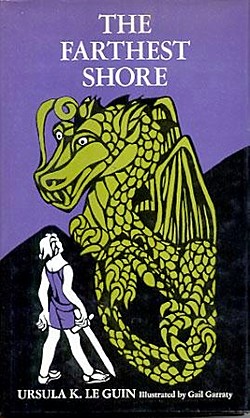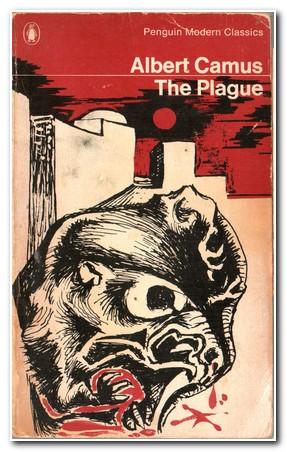10)
Hsing's Spontaneous Self-Flaying Sarcoma, documented by Liz Williams in
The Thackery T. Lambshead Pocket Guide to Eccentric and Discredited Diseases, ed. Jeff VanderMeer and Mark Roberts.
A day or so later, the outer layer of the epidermis splits at the temple into a series of lotus-like petals, apparently causing the victim to force his/her head into the nearest narrow gap (such as a window frame) rather in the manner of a snake attempting to aid the shedding of its skin. Rejecting all offers of help and attempts at restraint, the victim bloodlessly sloughs the skin, 'scrolling it down the torso and limbs in the manner of a tantalizingly unrolled silk stocking' (Mudthumper, p.1168).
OK, this one's not really contagious (as far as I know), so it only manages to
scraape its way onto the top ten. But it can also be considered a calling card for
Thackery's, which is a good source of plagues generally.
9)
Black Death AND Influenza in Connie Willis's time travel tale
The Doomsday Book. The time travel conceit allows Willis to compare social responses to epidemic centuries apart. A time traveller, washed up in a part of the past she never intended to visit, tries to summon up some advantage from her superior scientific understanding of events ...
She had tried to remember what remedies the contemps had tried while he was gone. They had carried nosegays of flowers and drunk powdered emeralds and applied leeches to the buboes, but all of those were worse than useless, and Dr Ahrens had said it wouldn't have mattered what they had tried, that nothing except antimicrobials like tetracycline and streptomycin would have worked, and those had not been discovered until the twentieth century.
8)
The plague in Daniel Defoe's 1722
Journal of the Plague Year, a hugely formative work in the history of the Western novel.
Thomas. You will go away. Whither will you go, and what can you do? I would as willingly go away as you, if I knew whither. But we have no acquaintance, no friends. Here we were born, and here we must die.
John. Look you, Tom, the whole kingdom is my native country as well as this town. You may as well say I must not go out of my house if it is on fire as that I must not go out of the town I was born in when it is infected with the plague. I was born in England, and have a right to live in it if I can.
Thomas. But you know every vagrant person may by the laws of England be taken up, and passed back to their last legal settlement.
John. But how shall they make me vagrant? I desire only to travel on, upon my lawful occasions.
Thomas. What lawful occasions can we pretend to travel, or rather wander upon? They will not be put off with words.
John. Is not flying to save our lives a lawful occasion?
7)
The Melding Plague in Alaistar Reynold's Revelation Space books. In a future where most folk are filled with cybernetic implants, this phenomenon fills those implants with a will to expand and go haywire. It tries to synthesise flesh and machine, and it affects both our bodies and our built environment. It's described as almost "purposeful" and almost "artistic."
The servitors lurched forwards, approaching the shattered angel of the Captain. More than ever he looked like something which had not so much crept with glacial slowness from his reefer, but had burst with volcanic ferocity, only to be frozen in a strobe flash. He radiated in every direction parallel to the wall, extending far into the corridor on either side, for dozens of metres. Nearest to him, his grawth consisted of trunk-thick cylinders, the colour of quicksilver, but with the texture of jewel-encrusted slurry, constantly shimmering and twinkling, hinting at phenomenally industrious buried activity. Further away, on his periphery, the branches subdivided into a bronchial-like mesh. At its very boundary, the mesh grew microscopically fine and blended seamlessly with the fabric of its substrate: the ship itself. It was glorious with diffraction patterns, like a membrane of oil on water.
HegSwarms in Iain M. Banks's Culture books, are more an example of
grey goo, "self-replicating nanotech out of control" trope: a plague propagating through all kinds of physical systems, and not just biological ones. From
Surface Detail:
Restoria was the part of Contact charged with taking care of hegemonising swarm outbreaks, when -- by accident or design -- a set of self-replicating entities ran out of control somewhere and started trying to turn the totality of the galaxy's matter into nothing but copies of themselves. It was a problem as old as life in the galaxy and arguably hegswarms were just that; another legitimate -- if rather over-enthusiastic -- galatic life-form type. [...] Even the most urbanely sophisticated, scrupulously empathic and excruciatingly polite civilisation, it had been suggested, was just a hegswarm with a sense of proportion.
Reynolds' Melding Plague is grey-goo-adjacent. It stands representative of those speculative sicknesses that are all about highly aestheticised kaleidescopic body horror: not grey goo so much as varicolored-crystalline-n-dimensional-irridescent-goo. There is a sense of a complex patterning logic for which we are the unfortunate substrate. See also Peter F. Hamilton's Zanth, Jeff VanderMeer's Area X (and Alex Garland et al.'s
Annihilation adaptation). Compare Reynold's more grey goo-ish Greenfly Terraformers. Hegemonising goos and singularities of various kinds appear in fiction by
Charles Stross, Greg Bear, Greg Egan, Rudy Rucker, Linda Nagata, and others.
6) The "
bad luck," as Sparrowhawk calls it at one point: the mysterious disenchantment in Ursula K. Le Guin's
The Farthest Shore. Once more not
strictly a plague, though it reproduces some of its logic. There is also a Patient Zero of sorts. See also e.g. Larry Niven's
The Magic Goes Away,
the Nothing in Michael Ende's
The Neverending Story, the Forge in Robin Hobb's
Assassin's Apprentice, etc. Within fantasy fiction, sometimes the source of the contagion is something a bit more like a hellmouth. These myriad magical contagions can sometimes be read as oblique commentaries on depression, despair, loneliness, paranoia, and other forms of psychic ill-being, and on capitalism's entwined processes of
atomisation, rationalisation, secularisation, and alienation.
5)
The bacillus in Richard Matheson's
I Am Legend (1954), which turns everyone into zombie-like vampires. A big influence on the filmmaker Romero and many a zombie story since. See also e.g. the Rage virus in
28 Days Later, the virus in Max Brooks's
World War Z,
the cordyceps infection in the
Last of Us games, and the viruses in Mira Grant's Newsflesh books. But virus or no virus, these kinds of apocalyptic zombie narratives are almost always closely associated with pandemics. Whether your zombies are fast or slow, eldritch or techno-scientific, whether they are partial to brains or just mad as hell, it's the
extreme contagiousness of the condition that is at the heart of this myth, and that differentiates the apocalyptic zombie from the "sorcerer's undead servant" style zombie. Spreading is the apocalyptic zombie's MO. Consider that vampirism and lycanthropy are also often supposed to be transmitted by a bite, yet vampires and werewolves -- Matheson's tale being a weird exception -- seldom
swarm.
4)
BlyssPluss in Margaret Atwood's
Oryx and Crake (2003). Here's a
working paper by Polina Levontin et al. about so-called "lone wolf" bioterrorism and apocalyptic science fiction.
3)
The Red Death in Edgar Allan Poe's '
The Masque of the Red Death.'
No pestilence had ever been so fatal, or so hideous. Blood was its Avatar and its seal—the redness and the horror of blood. There were sharp pains, and sudden dizziness, and then profuse bleeding at the pores, with dissolution. The scarlet stains upon the body and especially upon the face of the victim, were the pest ban which shut him out from the aid and from the sympathy of his fellow-men. And the whole seizure, progress and termination of the disease, were the incidents of half an hour.
2) The eponymous
plague of Albert Camus's existential novel
The Plague.
Honorable mentions: Wuhan Flu documented by Eric Schaller, Download Syndrome documented by Steve Aylett, Jumping Monkworm documented by Sara Gwenllian Jones, and many, many more in
Thackery T. Lambshead's Pocket Guide etc., the Plagues of Egypt in
The Book of Exodus, the plague in Lucretius's
On the Nature of Things, the pandemic in the game
Pandemic, the plague in
Plague Inc., Farmer's Tremors and
billions of other procedurally generated
Dungeons & Dragons diseases, the plague in Karen Lord's 'The Plague Doctors' (
downloadable here), Andromeda in Michael Crichton's
Andromeda Strain, the plague among livestock at Noricum in Virgil's
Georgics (thanks Abi), children's voices in Ben Marcus's
The Flame Alphabet (thanks Sam), the fast prion in Kim Stanley Robinson's
Aurora, Captain Trips from Stephen King's
The Stand (thanks everybody), the plague described in Boccacio's
Decameron, the notional plague on
both your houses in Shakespeare's
Romeo and Juliet, the plague in Chaucer's 'Pardoner's Tale', the parasite in Octavia Butler's
Clay's Ark, Georgia Flu in Emily St. John Mandel's
Station Eleven, Snow Crash in Neal Stephenson's
Snow Crash, Buscard's Murrain aka Wormwood in China Mieville's 'Entry Taken from a Medical Journal' (also in
Thackery's), Diseasemaker's Croup in Neil Gaiman's
Fragile Things (and
Thackery's), the femicidal plague in James Tiptree Jnr's 'The Screwfly Solution', the consumption 'plague' in Frederik Pohl's 'The Midas Plague,' the plague in Sandra Newman's
The Country of Ice-Cream Star, the bioweapon Clarity in Cory Doctorow's 'Chicken Little', the Motaba virus in the movie
Outbreak, the fog in the movie
The Fog, the 'ST-Demon' in the movie
It Follows, the Simian Flu in the Planet of the Apes movies, the mass infertility in P.D. James's
Children of Men, the Hopping Cough in
The Smurfs, the atavism-causing Barclay's Protomorphosis Syndrome in an episode of
Star Trek: The Next Generation and various other Trekkie plagues and contagions (Tribbles maybe?), the (mass but non-contagious) blindness in John Wyndeham's
Day of the Triffids, the blindness in H.G. Wells's 'Country of the Blind', the blindness in José Saramago's
The Blindness, the Wandering Sickness in H.G. Wells's
Shape of Things to Come, the Monte Carlo viruses in Greg Egan's 'Blood Sisters', the devastating Golgafrinchan plague transmitted via unsanitized telephone in Douglas Adams's
Restaurant at the End of the Universe, cholera in Gabriel Garcia Marquez's
Love in the Time of Cholera,
the plague in Anne McCaffrey's 'The Ship Who Mourned', smallpox etc. in Chelsea Quin Yarbro's
Time of the Fourth Horseman, Dryditch Fever in Brian Jacques's
Salamandastron, the Boston plague in Roger Zelazny's
Damnation Alley,
Amusica in Alaistar Reynolds's
Century Rain, GuiltTrip in Peter Watts's Rifter books, Salt Plague in Kate Elliott's Spiritwalker books, Grayscale and Pale Mare and the Spring Sickness in G.R.R. Martin's Game of Thrones series, Spattergroit in the Harry Potter books by anonymous, the Forge in Robin Hobbes's
Assassin's Apprentice and others in that series, Sevai and Vedet in Ursula K. Le Guin's
Always Coming Home, the White Blindness (myxy) in Richard Adams's
Watership Down, the noocytes in Greg Bear's
Blood Music, the cult virus in Linda Nagata's
Vast, and so on to ...
1)
The plague in Samuel R. Delany's remarkable metafictional novella,
The Tale of Plagues and Carnivals (1985, later expanded), which collages the swords-and-sorcery plague of Nevèrÿon into memoir, theory, and philosophy and poetics, wrestling with the 1980s AIDs epidemic in New York City.
"Listen to me." The actor pulled him back. "Rights, you say? You're not going to get the plague. You know that as well as I do! Me and my kind, we're the ones in danger. And do you think for a minute if I thought there was any right, reason, or efficacy to be gained by tearing down this bridge, I wouldn't have been here days ago with a hammer myself? But that's for us to decide. Not you -" The actor paused, because, from the bandy-legged worker's eyes, two very fat tears, first as glimmerings along his lower lids, then as irregular spills in the torchlight, moved down his dark cheeks toward his beard.
At one point Delany asks of characters of SFF, in what senses are their problems the same as his? And then: and in what senses are they different?
EDITS: Willis's Black Plague and Influenza double act added. Melding Plague added itself and incorporated Banks's HegSwarms.










